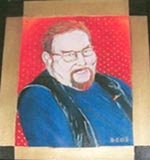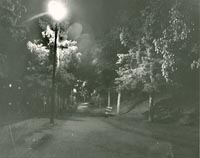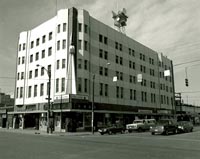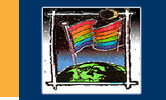Memoirs — Gens Hellquist
The Adventures of a Prairie Fag
Perceptions, The Gay & Lesbian Newsmagazine of the Prairies
Vol. 19, issue # 2, March 14, 2001.
 March
2001 marks the 30th anniversary of the beginning of efforts to build a gay and lesbian community in Saskatoon. While there were small groups
of gay men and other small groups of gay women going back at least to the 1920s, there were no organized initiatives to address the issues
that affected gay people until the first formal queer organization was begun in March 1971.
March
2001 marks the 30th anniversary of the beginning of efforts to build a gay and lesbian community in Saskatoon. While there were small groups
of gay men and other small groups of gay women going back at least to the 1920s, there were no organized initiatives to address the issues
that affected gay people until the first formal queer organization was begun in March 1971.
It's important for us to be aware of where we have come from and how we got to where we are today. The lessons of the past can help guide
our actions in the present and future. I have been part of the identified gay and lesbian community since I came out in 1965 at the tender
age of 19 and have been involved in establishing organizations and services in the queer community since I helped found the first queer group
in Saskatoon in 1971. This is also my 30th anniversary as a queer activist.
It has been a fascinating journey with times of sheer exhilaration and times of deep despair. I have had the honour and privilege to meet
and work with hundreds of wonderful men and women, gay and non-gay, who have toiled to build a place where all queer people are valued and
cherished.
This four-part series is a brief overview of my perceptions of Saskatoon's queer community. It is told through my eyes and others will have
somewhat different stories to tell; stories seen through their eyes. However one sees the events and issues, we all have shared in the passions
of carving out safe places for ourselves and our queer family.
Part 1
I was five when my family moved to Saskatoon in 1951. Already I was developing a sense that somehow I was different from those around me. I
didn't feel I fit or belonged somehow, but I had no idea what that difference was. For a time I questioned if perhaps I wasn't adopted because
I didn't feel that I fit with my family. It wasn't until I hit puberty that the reality of what that difference was hit me. Sex was one of those
things polite people didn't talk about in public during the 1950s and homosexuality was certainly never mentioned in polite company. When I was
13 I first heard the word 'homosexual' somewhere and something about it felt familiar. I ran to the dictionary to check on its meaning. I finally
had a term to describe my difference.
Obtaining information on homosexuality was next to impossible in the '50s. At times I wondered if I might be the only homosexual in Saskatoon
but somehow that didn't make sense. What I felt seemed so natural to me, although there were times when the thought of being homosexual terrified
me.
By my early teens I discovered physique magazines which amazingly
were readily available on newsstands throughout the city. I kept count of certain store's stock and soon realized that others were buying them.
While the magazines espoused the importance of physical health it was obvious to me that they were directed at people like me. Guys who like
other guys. I mean, all those photos of naked or nearly naked guys.
I had been having sex with a neighbourhood kid for a while but when he discovered girls I was left in the lurch. Cruising for other gay guys
became a mission for me except I had no idea of where to cruise. Cruising magazine racks in the corner drug store became a routine in my efforts
to meet someone else like me.
I did connect with one other guy through my cruising but I struck paydirt one afternoon in a downtown book store. We both noticed each other
checking out the physique magazines and when he left the store I got up the nerve to follow. As I exited the store I noticed him peering in the
store window next door. Somehow I summoned up the courage to approach him. We talked for a few minutes and he informed me that gay men met one
another in the park around the Bessborough Hotel.
That evening I hastily made my way down to the park and ran into the fellow I'd met earlier that afternoon in the book store. We sat on a park
bench and I quizzed him for hours about the park, the community, being gay and how to meet other men. He patiently answered my eager questions
and was my first mentor. I never did sleep with him and his name is lost in time but he was an important part of my discovering that I wasn't
alone.

The park became my second home during the summers. Most nights I would head down shortly after supper or after I was done coaching the little
league softball team I coached in those days. It was a form of community centre, or family, which provided a sense of belonging to those who
were fortunate enough to find it. While many went down there with thoughts of finding sex or perhaps even a relationship, for most it was primarily
a place where we had space to be who we were and support for who we were.
I also learned that gay men drank at the bar in the Bessborough Hotel as well as the bar in the King George Hotel. Apparently, both had been
places where gay men met for decades. Unfortunately one had to be 21 to enter a licensed establishment in those days and I was only 19. Coming
from a religious family, I still hadn't tasted my first drop of liquor. That first winter after discovering the park was a very long and lonely
one.
I soon developed a circle of friends who I would visit with regularly in the park. I was invited to house parties and taken under wing by a
couple of older gay men, one of whom I had a relationship with over one winter.
My visits to the park became an important part of developing a community and place to belong. I met my first lover down there and spent a glorious
month with him before he decided he wasn't ready yet, having just left his wife and two kids back in Ontario. I made new friends who accepted
and supported me and met people to sleep with.
While the park provided an important sense of community, it wasn't long before I became aware that I needed more. The evidence of alcoholism
and depression throughout the community of men I had met and become friends with was obvious. I wasn't out long before I heard that one of the
guys in the park crowd had killed himself because he couldn't live in a society that was so intolerant.
I finally learned to tolerate a rye and coke so I could connect with other people in the two bars available to us in Saskatoon. Usually a few
tables of gay men could be found huddled in a corner of the Cove room in the King George or at the long sit up bar in the Harlequin room of the
Bessborough Hotel.

By the late 1960s, word came back that there were private clubs for gay people in both Calgary and Edmonton. The news of the Stonewall
Riots also made its way to Saskatoon through the Georgia Straight, a counterculture magazine from Vancouver that carried information
about things gay. A few of us trekked off to Calgary to see this new gay club. We discovered it through an alley, in a back door and down in
the basement. Walking through those doors was an exciting and terrifying moment for me. Once inside I relaxed and started to enjoy the feeling
of being in a place where men and women could openly be themselves and, my gawd, openly dance with someone of the same sex. It was also the
first time I met lesbians as they had never been part of the park, bar or party scene that I was familiar with. Soon I was suggesting that
maybe we should try and start such a club in Saskatoon. My comments were usually met with replies like, "It would never work," "No
one would dare show up," etc. My enthusiasm for starting a "gay club" didn't wane, although I became less vocal about it, biding
my time.
I had developed a friendship with Dan Nalbach, a professor in, and later head of, the Drama Department at the University of Saskatchewan. Dan
was an American and brought along a Boys in the Band sensibility to gay life. Camp and bitching was an important part of his life as a
gay man and he tried to coach me and turn me into a proper fag. He became another important mentor in my life.
Before I met Dan he had initiated what he called the Stofford family with himself as the matriarch, or mother. I became his second daughter;
the first one had been aborted because he had done something that infuriated Dan. Mother added two other gay men as my sisters and the family
took off. It included two aunts and grew to include two other young gay men as my sisters and then two even younger men to be my daughters. Mother's
parties became notorious across the prairies.
While the Stofford family and the surrounding gay community provided an important part of family and belonging for me, it also felt uncomfortable
at times. The heavy drinking and deep depressions were common occurrences in the circle of friends I had developed and each year we heard of
a few more who committed suicide. I could never get really comfortable with the need to change pronouns for genders as well as the constant competitions
to see who could be the bitchiest and therefore the wittiest.
By 1971 I had finally convinced Dan that we should try and start a group for gay people in Saskatoon, something like the clubs in Calgary and
Edmonton that we had both visited. We knew that the small group of gay men we were aware of was only the tip of the iceberg. We needed something
in place and visible that would allow more people to come out and become part of our small queer community.
In March of that year we pooled our money and rented a post office box and forwarded a listing to the Georgia Straight in Vancouver.
In early April a listing that read "Saskatoon Gay Liberation, PO Box 3043, Saskatoon, SK" appeared in the community page of the publication.
Dan and I sat back waiting for the deluge of mail we expected to come in.
Part 1 | Part 2 |
Part 3 | Part 4


